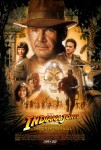 The Hollywood Reporter has a highly amusing article about a lawsuit filed by Dr. Jaime Awe, director of the Institute of Archeology of Belize, on behalf of the nation of Belize demanding that the current owner of the crystal skull that inspired the latest Indiana Jones movie return the artifact to Belize and that Lucasfilm and its new owner Disney give Belize a share of the film’s profits.
The Hollywood Reporter has a highly amusing article about a lawsuit filed by Dr. Jaime Awe, director of the Institute of Archeology of Belize, on behalf of the nation of Belize demanding that the current owner of the crystal skull that inspired the latest Indiana Jones movie return the artifact to Belize and that Lucasfilm and its new owner Disney give Belize a share of the film’s profits.
Dr. Awe’s position is that the crystal skull in question was illegally removed from Belize by Defendant Frederick Arthur Mitchell-Hedges (deceased) in 1930 after its discovery in the Mayan city of Lubaantun in 1924. Since Belize, then a colony called British Honduras, had laws on the books as far back as 1894 preventing the removal of artifacts from government-owned property, the skull was stolen and thus Belize is its legal owner. Besides, Mitchell-Hedges didn’t even have the proper permits to excavate the Mayan pyramids at Lubaantun, so his whole operation was illegal to begin with.
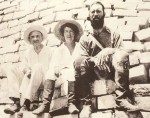 Awe alleges that Mitchell-Hedges, then his daughter Anna and now his daughter’s widower Bill Homann have all made money exhibiting and promoting the skull. Lucasfilm, Paramount and Disney have also profited from the skull. Although the skull itself was not used in Indiana Jones and the Kingdom of the Crystal Skull, a fictionalized version was. In the movie it was found in Peru, but it was called the “Mitchell-Hedges Skull” like its real life counterpart.
Awe alleges that Mitchell-Hedges, then his daughter Anna and now his daughter’s widower Bill Homann have all made money exhibiting and promoting the skull. Lucasfilm, Paramount and Disney have also profited from the skull. Although the skull itself was not used in Indiana Jones and the Kingdom of the Crystal Skull, a fictionalized version was. In the movie it was found in Peru, but it was called the “Mitchell-Hedges Skull” like its real life counterpart.
Given these facts, the current owner, Mitchell-Hedges’ son-in-law Bill Homann, must return the skull to Belize, its rightful owner, and Lucasfilm, Paramount and Disney must pay damages to Belize which has “a right, title and interest in and to the Mitchell-Hedges Skull and its likeness.” There’s basically no chance, in my entirely non-professional opinion, that the court will find the latter argument persuasive. If it does any research at all, it won’t find the former argument persuasive either.
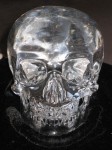 The reason for this is simple: there is no evidence whatsoever that Frederick Arthur Mitchell-Hedges actually found the crystal skull in Belize. I mentioned the background story in this entry way back in 2008 which links to an article in Archaeology magazine debunking the crystal skull mythos.
The reason for this is simple: there is no evidence whatsoever that Frederick Arthur Mitchell-Hedges actually found the crystal skull in Belize. I mentioned the background story in this entry way back in 2008 which links to an article in Archaeology magazine debunking the crystal skull mythos.
F.A. Mitchell-Hedges was a British adventurer, journalist and fabulist who promoted himself in his 1954 autobiography Danger, My Ally as a discoverer of “lost cities” with a Zelig-like ability to find himself at the crux of historic events. In 1913 he was kidnapped by Pancho Villa, who let him live solely because of his stirring rendition of “God Save the King” and then forced him to fight by his side for 10 months. In 1917 in New York he roomed with a Russian named “Bronstein” who turned out to have been Leon Trotsky. He may have been a spy for the British secret service, although he denied it in his autobiography.
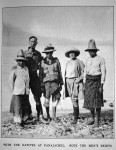 That doesn’t really matter, though, since you basically can’t believe a word he says. He claimed that in the early 1920s, while looking for a link between Atlantis and the Maya, he and his crew slashed and burned their way through the Belizean rain forest until they came across the “lost city” of Lubaantun. Lie. The locals knew about the ruins and told archaeologist Dr. Thomas Gann about them in 1903. He explored the site and published several papers about it. Another expedition in 1915 followed, and then Gann returned in 1924, bringing Mitchell-Hedges with him.
That doesn’t really matter, though, since you basically can’t believe a word he says. He claimed that in the early 1920s, while looking for a link between Atlantis and the Maya, he and his crew slashed and burned their way through the Belizean rain forest until they came across the “lost city” of Lubaantun. Lie. The locals knew about the ruins and told archaeologist Dr. Thomas Gann about them in 1903. He explored the site and published several papers about it. Another expedition in 1915 followed, and then Gann returned in 1924, bringing Mitchell-Hedges with him.
There is no contemporary documentation recording the discovery of a crystal skull on the 1924 dig. Mitchell-Hedges himself didn’t mention it until his autobiography, even though he wrote plenty of juicy adventurous stories about the Lubaantun expedition in which he starred as the intrepid discoverer and Dr. Gann was nowhere to be found. His 1954 account of the discovery of the crystal skull is less than precise. “How it came into my possession,” he wrote ominously, “I have reason for not revealing.” He called it the Skull of Doom. “It is said that when [the high priest] willed death with the skull, death invariably followed. It has been described as the embodiment of evil.” Yes quite.
After F.A.’s death in 1959, his adopted daughter Anna took on her father’s great bullshitting mantle. In 1968 she wrote to art conservator Frank Dorland, who was studying the crystal skull, that she herself found the piece when she joined her father on his last expedition to Lubaantun in 1926. She later changed her story to a far juicier version. This time she was just a teenager when she found the skull, accompanying her father on the 1924 expedition. Against his wishes, she climbed the tallest pyramid while everyone else was having their siesta because she had heard that you could see the ocean from up there. Instead she saw through gaps in the rock what looked like a light shining inside the pyramid.
Her stern but loving father admonished her upon her return, but curious about her story he and his crew broke a hole in the side of the pyramid just big enough for a little person to squeezle through. On January 1st, 1924, Anna’s 17th birthday, the crew lowered her into the pyramid by two ropes. She was scared. There were scorpions and God knows whatall else in there. She saw the skull, stuffed it in her shirt and had the crew lift her back out. As soon as the Maya villagers saw what she had found, they began to weep and moan and bow before the skull.
Seeing their reaction, Mitchell-Hedges gave the skull to the high priest, who put it on an altar surrounded by a fire that was kept roaring 24 hours a day. Maya people came from all over to see the skull. It stayed there for years until the high priest gave the skull back to F.A. during the 1926-1927 expedition either for “safekeeping” or in thanks for the food and medicine he had given them, depending on which day Anna was telling the story.
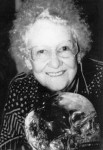 Mitchell-Hedges kept it until his death, then Anna kept it (with occasional gaps when she loaned it out, like to Dorland) until her death in 2007, leaving it to Bill Homann whom she married in 2002 when she was 95 and he was almost 40 years younger. (Homann prefers to think of her as his mentor; according to him the marriage was for insurance purposes.) Bill continues to tell Anna’s story to this day. For him it’s the Skull of Love full of positive vibrations and groovy things, not the Mitchell-Hedges Skull of Doom, and he travels the country taking the skull with him on personal appearances. You can hear him regale a nice New Age crystals-and-chakras lady with it in this interview (the crystal skull part starts at the 5:00 point and goes on a loooong time).
Mitchell-Hedges kept it until his death, then Anna kept it (with occasional gaps when she loaned it out, like to Dorland) until her death in 2007, leaving it to Bill Homann whom she married in 2002 when she was 95 and he was almost 40 years younger. (Homann prefers to think of her as his mentor; according to him the marriage was for insurance purposes.) Bill continues to tell Anna’s story to this day. For him it’s the Skull of Love full of positive vibrations and groovy things, not the Mitchell-Hedges Skull of Doom, and he travels the country taking the skull with him on personal appearances. You can hear him regale a nice New Age crystals-and-chakras lady with it in this interview (the crystal skull part starts at the 5:00 point and goes on a loooong time).
So that’s the tallest tale of the discovery of the crystal skull. There is zero evidence any of it is true, and quite a bit of evidence that it’s not. Besides Mitchell-Hedges’ own uncharacteristic reticence to mention it when self-promoting his faux discovery of the not-really-lost city of Lubaantun, there’s also positive evidence of a whole other provenance.
A 1936 article in Man, the journal of the Royal Anthropological Institute of Great Britain and Ireland, compared two crystal skulls, one of them in the British Museum (where it still resides) and the other belonging to London art dealer and antiquities collector Sydney Burney. The two skulls were almost identical in material and overall design, with the latter being more intricately carved around the eyes and jaw. The measurements of the Burney skull match the Mitchell-Hedges skull exactly. Burney put it up for sale at a Sotheby’s auction in 1943. A note in the archives of the British Museum says that it didn’t sell at the auction, but that one F.A. Mitchell-Hedges bought it from Burney in 1944 for 400 pounds. That would explain why he never mentioned it twenty years earlier.
almost identical in material and overall design, with the latter being more intricately carved around the eyes and jaw. The measurements of the Burney skull match the Mitchell-Hedges skull exactly. Burney put it up for sale at a Sotheby’s auction in 1943. A note in the archives of the British Museum says that it didn’t sell at the auction, but that one F.A. Mitchell-Hedges bought it from Burney in 1944 for 400 pounds. That would explain why he never mentioned it twenty years earlier.
When questioned about the Burney evidence, Anna claimed that Mitchell-Hedges had “loaned” the skull to Burney in exchange for money to finance an expedition. When he saw an ad in the newspaper advertising the Sotheby’s sale, Mitchell-Hedges bought the skull back. Possible, I suppose, but I can’t say I find it persuasive.
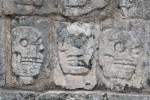 Then there’s the physical evidence. Jane MacLaren Walsh, archaeologist with the Smithsonian Institution and author of the Archaeology magazine article linked above, examined the Mitchell-Hedges skull in 2007 and found tool marks left by high-speed diamond-coated rotary cutting implements which would not have been part of the toolkit of 3,600-year-old Mayans. She believes it’s a copy of the British Museum skull, only with more elaborate features added like the articulated mandible and realistic teeth. Both of them date no earlier than the late 19th century, in her opinion, a time when skull art was very much in fashion.
Then there’s the physical evidence. Jane MacLaren Walsh, archaeologist with the Smithsonian Institution and author of the Archaeology magazine article linked above, examined the Mitchell-Hedges skull in 2007 and found tool marks left by high-speed diamond-coated rotary cutting implements which would not have been part of the toolkit of 3,600-year-old Mayans. She believes it’s a copy of the British Museum skull, only with more elaborate features added like the articulated mandible and realistic teeth. Both of them date no earlier than the late 19th century, in her opinion, a time when skull art was very much in fashion.
The iconographic evidence is also stacked against the authenticity of the skull. There are no other relatively realistic skulls like this to be found in Mayan art. They either used actual human skulls or they carved them in stylized hieroglyphics and reliefs.
 Meanwhile, even if the Mitchell-Hedgeses didn’t make up their many and varied skull stories, Bill Homann’s ownership is not clear. Several nieces and nephews of Anna’s contested the will, so until the whole probate issue is decided for good, Belize and Dr. Awe couldn’t touch the skull anyway. It’s a fun read of a lawsuit, though. Unlike most of its ilk, it’s short, sweet and thin on jargon. Thin on archaeology too, since it just accepts Anna’s story as fact so that Belize can piggy-back off the success of the crystal skull. Enjoy it below.
Meanwhile, even if the Mitchell-Hedgeses didn’t make up their many and varied skull stories, Bill Homann’s ownership is not clear. Several nieces and nephews of Anna’s contested the will, so until the whole probate issue is decided for good, Belize and Dr. Awe couldn’t touch the skull anyway. It’s a fun read of a lawsuit, though. Unlike most of its ilk, it’s short, sweet and thin on jargon. Thin on archaeology too, since it just accepts Anna’s story as fact so that Belize can piggy-back off the success of the crystal skull. Enjoy it below.